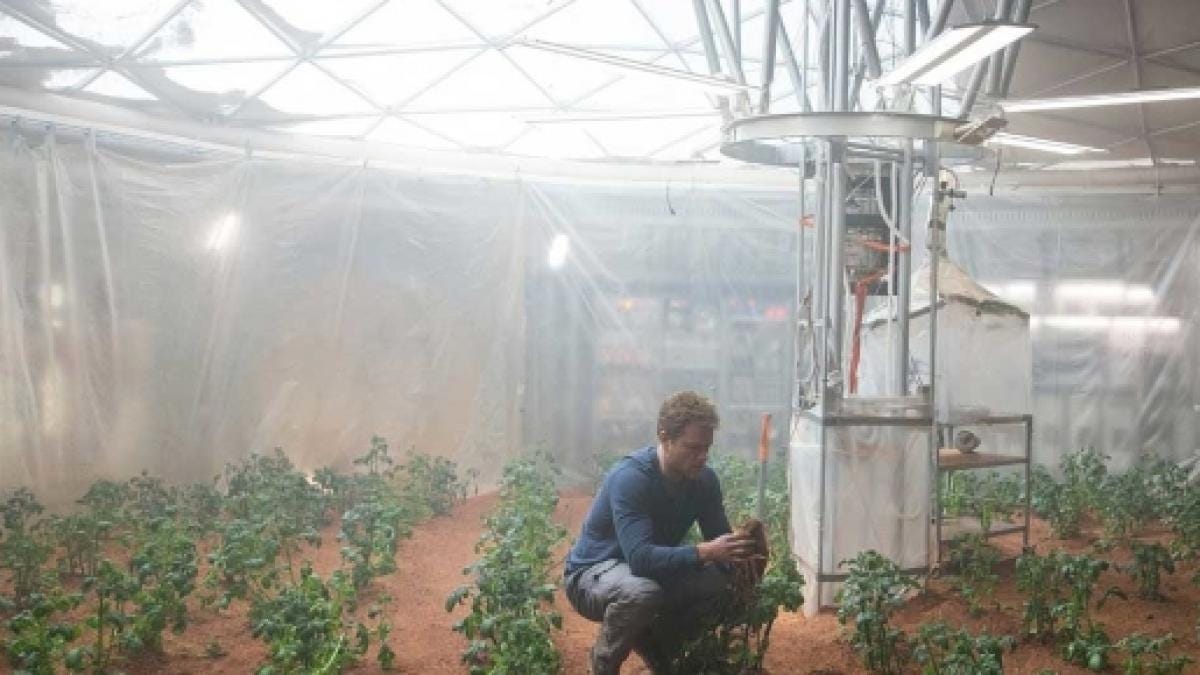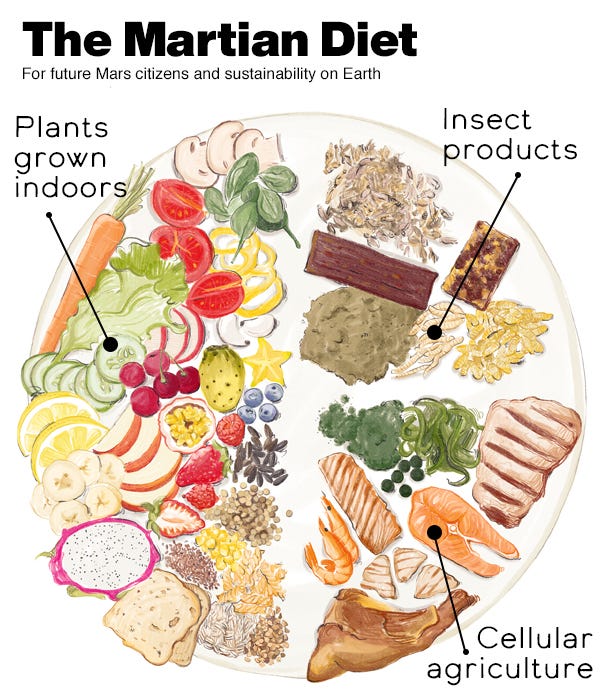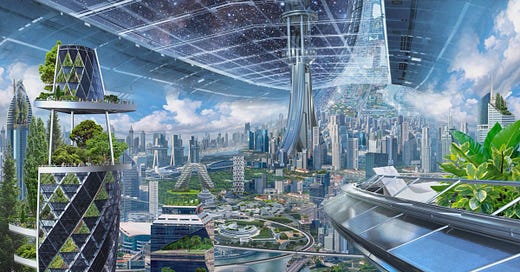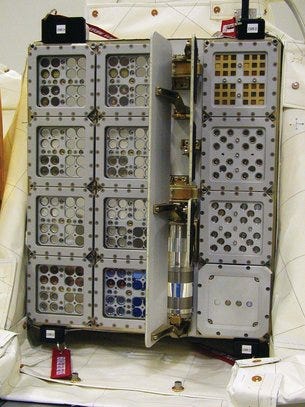It’s bizarre (but so fun) to say: A sustained human presence in deep space within the next few decades now seems inevitable. Two of the world’s wealthiest private individuals, Jeff Bezos and Elon Musk, are pumping billons into their dueling visions of human colonies outside of Earth that is fueling a revolution in rocketry and a second Space Race. Whether we end up with floating cylinder worlds (Bezos’ vision), a Mars colony (Musk’s and Richard Branson’s vision), or some other place outside “Spaceship Earth,” people will need to eat. A new food system will need to be built and its resulting cuisine will look radically different than than the glorified lunchables astronauts take on short term missions into low Earth orbit now. Packing sack lunches makes sense for the International Space Station about 400 kilometers from Earth, but not building a sovereign society tens of millions of kilometers away (such as is the case of Mars).
Musk envisions sending 1 million people to Mars in the next 100 years to establish a permanent colony. What will they eat? Not much attention is yet paid to the question of the agrifood of space outside of a few dedicated agencies, NGOs, and astrophiles — at least in relation to the cacophony of food TV, cook book slinging, and junk food designing in Western food culture. In this article, I’ll make predictions for what Deep Space or Martian cuisine may look like based on some governing principles that arise from the environment. I’ll also highlight some categories of players in this thin “space” and make a few predictions for how agrifood will look different than on Earth.
Principles for Martian (or Bezocylindrian?) cuisine

This is obviously a technology frontier that’s hard to predict and each “colony” would have its own unique agriculture system, cuisine, and food culture. However, there are common constraints and goals that will lead to common principles underlying those systems. Those principles:
Self-sufficiency (food sovereignty): As Elon Musk put it “‘The [Martian] city has to survive if the resupply ships stop coming from Earth”. I don’t think it’s efficient (or reasonable) to plan on bringing “a million tons” of vitamin C to Mars, as Musk claims. Using Earth resources to resupply exo-settlements would quickly turn into a destructive resource suck that drains our planet. Instead, the popular concept of “in situ resource utilization” (ISRU) prevails — use what is available like solar radiation and regolith (inorganic ‘dead’ soil). Underground solar-powered hydroponic farms are a favorite of Musk, and it’s possible that advances in soil microbiology could lead to the terraforming of the soil. This gives the concepts of locavorism and terroir a new meaning.
Circularity: Without natural ecosystems to recycle inorganic and organic materials (like fungi, bacteria, plant, and animal communities), agriculture must be designed for the first time to be “anthrosymbiotic.” That means, having a directly symbiotic/circular relationship with humans and their waste streams, particularly through consuming CO2, producing oxygen, and eating food/industrial wastes. Livestock and insects probably aren’t ideal, but phototrophs and extremophiles probably are. Also, avoiding waste may finally become a human priority, which would drastically change our consumption patterns and product formats. Re-flavorable chewing gum as a small example, perhaps?
Resilience (food security): The deathly importance of food security mixed with the extreme conditions of space pose a big challenge. Temperature can fluctuate between hundreds of degrees both above and below zero, in addition to intense solar radiation, and absence of backup tools or resources. Extremophile organisms such as lichens (which, like the Trisolarians for my fellow Three Body Problem fans, have been found to be nearly indestructible in tests at the ISS) will at least be a failsafe. There is also the Yellowstone-hotspring-dwelling Fusarium fungi strain flavolapis discovered by NASA research that is currently being cultivated by Nature’s Fynd (and their $150MM fundraised). Additionally, a crop disease could be disastrous too, creating the need for biosecurity protocols. Maybe tardigrades could be on the menu if things go badly.
Programmability: There are thousands of proteins, lipids, and other molecules that serve important nutritional and culinary functions. They currently come from the diverse bounty of foods on Earth, but that cornucopia likely isn’t an option. That’s where the “biofoundry” concept (like Ginkgo BioWorks/Motif FoodWorks) comes in. Using microbial precision fermentation and gene editing tools like CRISPR, genetic code could be sent electronically rather than physically — kind of like emailing a file to a 3D printer. This kind of thing might even be easier in microgravity, which can ease the transfer of genetic information (at least in plants).
Nourishing: Nutrition science will take on a renewed vigor. Factors like protein digestibility-corrected amino acid scores (PDCAAS), fighting oxidative stress, cancer inhibition, and nutrient density will matter more. Soy protein isolate and mycoprotein both have higher PDCAAS scores than meat and will play a big role. Mycoprotein is relatively unstudied, but a 2020 study found that it builds muscle better than milk protein and more research is coming.
Microgravity friendly: Mars has roughly 37% the gravity of Earth (whereas a rotating Bezocylindar may have artificial gravity approximating Earth). The relative gravity level impacts the chemical, mechanical and biological aspects of food. Difficulties with carbonization and it’s impact on the gastrointestinal system made fizzy beverages challenging (“wet burps”). Fear not though, AB InBev is already working with NASA toward its aspiration of being the first beer on Mars (probably with a different formulation). Even distilled booze may taste differently. As an experiment by Scotch whiskey maker Ardbeg showed, liquor can age drastically differently in microgravity. Issues like bread crumbs can be dealt with by avoiding crumbly foods or applying molecular gastronomy techniques like spherification with sodium alginate.
Water and land efficient: This one is straightforward. Water is likely to be scare, so plants whose vegetative states greedily hoard it (though a circular system may capture the water eventually) aren’t the top picks. Current versions of many nuts, rice, and corn are water intensive compared to potato, tomato, beets, beans, and onions/garlic — though all pale in comparison to all forms of livestock. The size of the organisms and the density they can be grown will also be essential.
Tasty (morale boosting): Life in an exo-settlement might be cool, but would definitely be grueling, dangerous, and restrictive. I assume that people will never stop loving food, at least until there are perfect chemical supplements that can fire the dopamine receptors like a greasy slice of pizza. Having familiar and diverse food options and camaraderie around eating could be make-or-break for the morale of space citizens and the ability to attract replacements. An added layer of difficulty is that food can taste differently in space, likely due to volatile compounds moving differently through the different atmosphere and gravity fields. Plus, sinus congestion is common resulting in dulled senses and the desire for spicier food. If palates change, so might the desirable flavors, textures, smells, and even shapes of popular foods. If Musk wants to attract top talent to Mars, he should start seriously thinking about food as a workforce development tactic and invest in the underlying science now.
Fractionation/Valorization: Versatility of applications for crops (defined broadly) will be a huge value-add. It’s likely that a plant (or fungi) will be put to full use. For example, if not consumed whole, the starches, oils, proteins, plus inedible bits like stems and leaves, could be used to make pastas, medicines, or building materials. Those organisms that have the highest aggregate value for all their uses will likely be propagated in the system of corpo-evolution in space (a concept Michael Pollan addresses in The Botany of Desire).
Players
Like rocketry, telecomms, GPS, and many more technologies, the agrifood system of space has largely started as the realm of governments, researchers, and esoteric non-profits. The beginnings of a commercial landscape in astro-agriculture is starting to coalesce.
Government/Academic/NGO
Governments: Obviously, the space agencies are on it, but perhaps not as far along as you’d expect. NASA’s Johnson Space Center Advanced Food Technology Project is actively exploring ways to move beyond processed packaged foods. NASA and the Canadian Space Agency recently announced a joint “Deep Space Food Challenge” offering financial prizes for ideas on food production technologies for deep space. The European Space Agency has plans to grow onion, tomatoes, soy, potatoes, lettuce, spinach, wheat, and spirulina algae in space.
Academic labs: MIT’s Space Exploration Initiative is doing a lot of interesting work here as is Dr. Sian Proctor.
NGOs: Beta Space hosts a yearly conference that looks like the Burning Man of space tech, with a high number of food tech founders participating. HiSEAS runs test missions in remote areas that will be useful for testing diets and cultural effects of food. EatLikeAMartian has a nice white paper on this very topic.
Commercial
Ultimately, the large food & beverage companies that dominate the terrestrial consumer goods industry will set their sights on the stars — it especially seems to be the cosmic destiny of Mars Food, Inc. But, while they’re busy concocting different ways of selling corn syrup and processed meats, innovators are taking the lead on the systems that will underpin space food (well beyond dehydrated “astronaut” foods like Tang or dried ice cream).
Dedicated space culinary platforms: I’ve seen a few design firms dedicated to space food like Zero G Kitchen (makers of a space oven), Mission: Space Food, and Space Zab in Thailand (with a prototype 3D "space printer”). Nanoracks has a space farming center and acts like a kind of space tech accelerator that has helped companies run experiments at the ISS.
Circular farming: Another type of platform play is groups focused on complete agricultural systems in space (think hydroponics and carbon recycling) including Orbital Farm and Deep Space Ecology.
Microbial fermentation: The roughly 50 companies dedicated to precision or biomass fermentation have promising applications to astro-agriculture. Nature’s Fynd, Air Protein, and Solar Foods in particular have roots in NASA research or space applications. Turning CO2 into protein immediately evokes space aspirations.
Microalgae. Microalgae like spirulina are a great fit for space because, like plants, they are phototrophic (convert sunlight to energy and CO2 to oxygen). Microalgae can be used as a sustainable fermentation host for valuable molecules, with companies like Spira and Provectus Algae already working on it.
Space manufacturing: The landscape of chemicals, materials, pharmaceuticals, and even organ manufacturing in space is booming (see, e.g., Vardaspace, ChemVita). Cellular agriculture (CellAg) in bioreactors seems like a natural fit for these manufacturing platforms.
Cell-based meat: One form of CellAg that has already been proven in low Earth orbit is cell-based meat. In 2019, Aleph Farms and Finless Foods collaborated with 3D Bioprinting Solutions to produce steak and fish, respectively, on the ISS. Big time Star Trek replicator vibes here. Bezos and Musk should join the likes of Richard Branson, Bill Gates, Sergey Brin, and even Musk’s brother Kimbal in investing in cell-based meat cultivation.
Private aerospace companies: SpaceX, Blue Origin, Virgin Galactic, and Boeing don’t yet seem to be doing much in astro-agriculture (at least publicly). Lockheed Martin appears to be involved with meal planning for the first NASA Mars mission (as well as shuttle design).
The Deep Future of Food: Synthesis
We are on the cusp of becoming a multi-planetary species, and it’s exciting that we may be designing the food system that could feed 99+% of all humans that will ever live. Hopefully we can develop technologies to help save Earth along the way. I’ll end with a few predictions for how the deep future of space food could look different than today.

Animal free: We might bring some small animals for food, companionship, or testing (though hopefully replaced by organ-on-a-chip technology). It’s hard to imagine that we will build an astro-livestock industry that will actively compete with human carrying capacity for water, space, oxygen, and food when there are now many alternatives like plant-based meats in development. Plus, we will be able to make animal proteins and cells directly through cellular agriculture much more efficiently without the risk of zoonotic disease vectors.
Techno-progressivist: GMOs, synthetic biology, and cellular agriculture (fermentation and cell-based meat) will be too valuable to set aside due to political unpopularity. The programmability of DNA and power of biomanufacturing will be important enablers of deep space exploration in their own right. “Golden meat” in space is does not seem likely to meet the same unfortunate fate as “golden rice” on Earth.
Microorganism rich: Microbes like fungi and bacteria are the true sources of protein. They actually create essential amino acids from fundamental building blocks, unlike animal cells and plant cells which rather merely accumulate them. We will see a “Second Domestication” of upcycling organisms like fungi to fill a variety of culinary and nutritional niches.
New staple crops: Not too different than Earth, but it looks like wheat, soybeans, corn, peanuts, tomato, onion, spinach, beets, spirulina, and (sweet) potatoes are among the early favorite to become staples.
New delicacies: Seemingly banal, but resource-intensive Earth foods (e.g., tree fruit, BBQ brisket, wood-fired pizza) could become delicacies, particularly if we can’t use technology to replicate them off-planet.
Changing food culture: In the data-driven, business-first world of space colonization, new eating habits like micronutrient tracking or intermittent fasting, or even or old ones like ceremonial feasting may take root.
What do you think? What did I miss and how do you think the future of food in deep space will look? Comments are open! If you like this kind of thing, feel free to subscribe and share. In the past I’ve covered mycelium innovation, synthetic spider silk, and microbiomics.








The food landscape outline above makes sense and paints a fascinating picture! In addition to food, we would need water, oxygen, temperature compatability, etc. EO Wilson is of the view that humanity will not be able to survive on another planet due to the complexity and interconnectedness of our relationship with planet Earth. What is your view on that?
Great article and lots of good resources. I personally think that the focus on replicating existing foods is overdone. Already, junk food companies are constantly innovating foods that don't look like anything in existence. Why not have a barbecue-flavored protein chip that has the ideal mix of essential amino acids, an addictive eating experience and all the goodies that meat has?
Before sending astronauts on a 2-year mission, they better eat the Mars menu on Earth, so that we know it doesn't kill them or create allergies. That will get them used to new foods, so it's not a sudden shock to say goodbye to pizza and oranges.